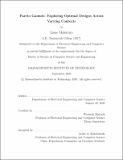| dc.contributor.advisor | Wojciech Matusik. | en_US |
| dc.contributor.author | Makatura, Liane. | en_US |
| dc.contributor.other | Massachusetts Institute of Technology. Department of Electrical Engineering and Computer Science. | en_US |
| dc.date.accessioned | 2021-01-11T17:19:51Z | |
| dc.date.available | 2021-01-11T17:19:51Z | |
| dc.date.copyright | 2020 | en_US |
| dc.date.issued | 2020 | en_US |
| dc.identifier.uri | https://hdl.handle.net/1721.1/129366 | |
| dc.description | Thesis: S.M., Massachusetts Institute of Technology, Department of Electrical Engineering and Computer Science, September, 2020 | en_US |
| dc.description | Cataloged from student-submitted PDF version of thesis. | en_US |
| dc.description | Includes bibliographical references (pages 69-73). | en_US |
| dc.description.abstract | Manufactured parts are meticulously engineered to perform well with respect to several conflicting metrics, like weight, stress, and cost. The best achievable trade-offs reside on the Pareto front, which can be discovered via performance-driven optimization. Objective functions used to define the Pareto front often incorporate assumptions about the context in which a part will be used, including loading conditions, environmental influences, material properties, or regions that must be preserved to interface with a surrounding assembly. Existing multi-objective optimization tools are only equipped to study one context at a time, so engineers must run independent optimizations for each context of interest. However, engineered parts frequently appear in many contexts: wind turbines must perform well in many wind speeds, and a bracket might be optimized several times with its bolt-holes fixed in different locations on each run. In this paper, we formulate a framework for variable-context multi-objective optimization. We introduce the Pareto gamut, which captures Pareto fronts over a range of contexts. We develop a global-local optimization algorithm to discover the Pareto gamut directly, rather than discovering a single fixed-context "slice" at a time. To validate our method, we adapt existing multi-objective optimization benchmarks to contextual scenarios. We also demonstrate the practical utility of Pareto gamut exploration for several engineering design problems. | en_US |
| dc.description.statementofresponsibility | by Liane Makatura. | en_US |
| dc.format.extent | 73 pages | en_US |
| dc.language.iso | eng | en_US |
| dc.publisher | Massachusetts Institute of Technology | en_US |
| dc.rights | MIT theses may be protected by copyright. Please reuse MIT thesis content according to the MIT Libraries Permissions Policy, which is available through the URL provided. | en_US |
| dc.rights.uri | http://dspace.mit.edu/handle/1721.1/7582 | en_US |
| dc.subject | Electrical Engineering and Computer Science. | en_US |
| dc.title | Pareto Gamuts : exploring optimal designs across varying contexts | en_US |
| dc.title.alternative | Exploring optimal designs across varying contexts | en_US |
| dc.type | Thesis | en_US |
| dc.description.degree | S.M. | en_US |
| dc.contributor.department | Massachusetts Institute of Technology. Department of Electrical Engineering and Computer Science | en_US |
| dc.identifier.oclc | 1227278307 | en_US |
| dc.description.collection | S.M. Massachusetts Institute of Technology, Department of Electrical Engineering and Computer Science | en_US |
| dspace.imported | 2021-01-11T17:19:50Z | en_US |
| mit.thesis.degree | Master | en_US |
| mit.thesis.department | EECS | en_US |
